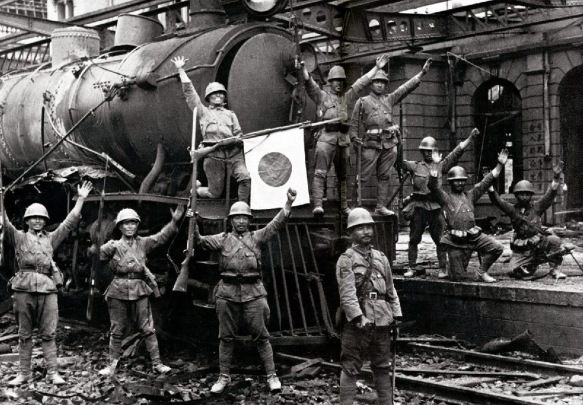Japanese troops.
Chinese Troops.
On January 26, 1938, the Japanese launched their offensive towards Xuzhou and by the evening of March 24, 1938, the Japanese 10th division (with around 25,000 men and around 100 tanks and armored cars) had reached the Taierzhuang area. The Japanese had conquered huge swathes of Northern and Eastern China and were steadily pushing deeper into China. With the conquest of Shanghai, Beijing, and Nanjing in 1937, Jiang Jie Shi (Chang Kai Shek) had moved his headquarters to Wu Han. The Japanese seeing an opportunity struck to capture the important rail junction of Xuzhou endangering Wu Han and forcing a Chinese capitulation.
The KMT generals also saw an opportunity to lure Japanese forces into a cul-de-sac and then encircle them with numerically superior Chinese forces. The town of Taierzhuang was chosen as the site for this trap as it was an important rail terminus on the way to Xuzhou. What followed is sometimes known as the “Samurai Stalingrad”, as huge amounts of forces fought over a small town. This scenario has been repeated many times hence, at Ponyri Station, July 1943, at Stalingrad 1942, at Hue, 1968, and so on. The Chinese “lure” was fed by Japanese arrogance and bravado in their attitude of their invading army. To them, they were supreme over all others. The Russian volunteers played a key role in their support of providing pilots for the Russian I-15, I-16 aircraft. Ironically, the Chinese forces were armed with and odd mix of German and non-German weapons.
Taierzhuang was a battle of numbers, as no amount of skill or bravado will can win a battle without additional reinforcements. Here, the Chinese had the superiority and no reinforcements were forthcoming to the Japanese 10th Division whose spearhead was in a fragile position. Thus, the stage was set.
#
#
The battle involved a Japanese plan to conquer Xuzhou, a major city in the East. However, the Japanese failed to consider the plans of generals Li Zongren and Bai Chongxi, who planned to encircle the Japanese in the town of Tai’erzhuang. The Japanese operation started on 24 March. Overconfidence led the Japanese commanders to overlook the thousands of inconspicuous “farmers” in the area, who were affiliated with Li Zongren and cut communication lines and supplies, diverted streams, and ruined rail lines. By late March, supplies and fuels were being dropped from airplanes to Japanese troops, but the quantities were insufficient.
On 29 March 1938, a small band of Japanese soldiers tunneled under Tai’erzhuang’s walls in an attempt to take the city from within. They were caught by the Nationalist defenders and killed. Over the next week, both sides claimed to hold parts of the city and surrounding area, and many were killed in small arms battles.
Finally, the Japanese attacked frontally, failing to consider the greater Chinese numbers. A major encirclement on 6 April, with Chinese reinforcements, preceded a major Japanese defeat and retreat, which the Chinese failed to capitalize upon fully through pursuit due to a lack of mobility.
The Chinese captured 719 Japanese soldiers and large quantities of military supplies, including 31 pieces of artillery, 11 armored cars, 8 armored fighting vehicles, 1,000 machine guns and 10,000 rifles.
A “dare to die corps” was effectively used against Japanese units.
Chinese suicide bomber putting on an explosive vest made out of Model 24 hand grenades to use in an attack on Japanese tanks
Due to lack of anti-armor weaponry, Suicide bombing was also used against the Japanese. Chinese troops strapped explosives like grenade packs or dynamite to their bodies and threw themselves under Japanese tanks to blow them up. Dynamite and grenades were strapped on by Chinese troops who rushed at Japanese tanks and blew themselves up. During one incident at Taierzhuang, Chinese suicide bombers obliterated four Japanese tanks with grenade bundles.
Amid the celebrations of the victory in Hankow and other Chinese cities, Japan tried to deny and ridiculed the reports of the battle for days. It was reported in the world’s newspapers, however, and by mid-April had provoked a Cabinet crisis in Tokyo.
The Chinese scored a major victory, the first of the Nationalist alliance in the war. The battle broke the myth of Japanese military invincibility and resulted in an incalculable benefit to Chinese morale.
